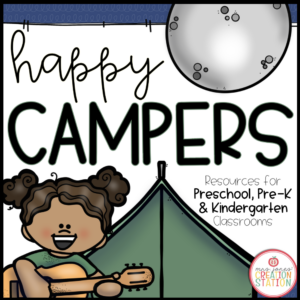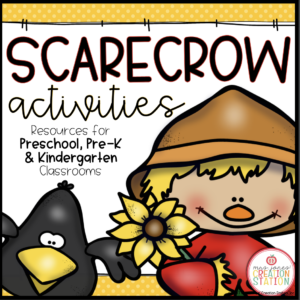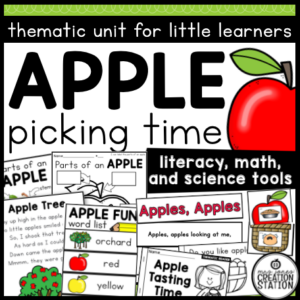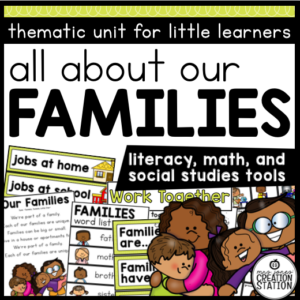Menu
Get your students excited about learning more about planets and space using this Solar System Thematic Unit.
This resource includes space thematic lessons, activities, poems, songs and centers for your little learners.
Buy the BUNDLE and SAVE! You can purchase this resources in the Thematic Activities for Little Learners Bundleand the Little Learners Mega-Bundle!
____________________________________________________________________
THIS RESOURCE INCLUDES
Week 25 Plans
This is a template for lesson plans during a space unit. Pick and choose what ideas and resources work for your learners.
Space – Whole Group
These resources can be used during whole group instruction for a space theme. They include a poem, word cards, tracing page and table sign in sheets.
Space Interactive Poem
Use this poem during a thematic lesson, whole group or a literacy center and have learners name things that are found in space.
Space Thematic Plans
Use these plans as a guide for engaging solar system read alouds and activities in the classroom.
Up In Space Song
Use this song throughout the unit about taking a trip through space.
Me and Space
Read Me and My Place in Space and have learners create an astronaut craft as to add to their Me and Space booklet.
Astronauts
Read Astronaut Handbook and complete the Astronaut chart together. Have learners complete the page in the booklet.
The Sun and Moon
Read The Sun and the Moon and write down facts together on a chart. Have learners write the facts in their booklet.
The Stars
Read The Sky is Full of Stars or Our Stars and answer the questions. Have learners write the definitions and create their own constellation.
The Solar System
Read The Planets in Our Solar System and put the planets in order on the chart. Have learners write the names of the planets in their booklet.
Space Sensory Charts
Explore space with the five senses. Complete the charts together and have learners draw and write about what they believe space to be like using their senses on the interactive page.
Up In Space Class Book
Use this resource to create a class book from the predictable chart created during the week.
Literacy Center | Alphabet Pocket Chart
Have learners match the alphabet cards on a pocket chart.
Literacy Center | Missing Sound
Have learners match the missing vowel sound on each word card.
Literacy Center | Rhyming Puzzles
Have learners match the puzzles by finding the pictures that rhyme.
Math Center | Counting to Twenty
Have learners put the numbers to twenty in order by counting up or counting down.
Math Center | Shape Sort
Have learners sort the shape pictures on the shape mats.
Math Center | Teen Number Mats
Have learners count and write the number on each mat.
Community Helpers Thematic Unit
Dinosaur and Fossils Thematic Unit
TEKSLA.K.5.G
The student expects to: evaluate details to determine what is most important with adult assistance;
TEKSLA.K.5.H
The student expects to: synthesize information to create new understanding with adult assistance; and
TEKSLA.K.5.I
The student expects to: monitor comprehension and make adjustments such as re-reading, using background knowledge, checking for visual cues, and asking questions when understanding breaks down with adult assistance.
TEKSLA.K.8.D.i
The student expects to: recognize characteristics and structures of informational text, including: the central idea and supporting evidence with adult assistance;
TEKSLA.K.8.D.ii
The student expects to: recognize characteristics and structures of informational text, including: titles and simple graphics to gain information.
TEKSMA.K.2.A
The student expects to: count forward and backward to at least 20 with and without objects;
TEKSMA.K.2.B
The student expects to: read, write, and represent whole numbers from 0 to at least 20 with and without objects or pictures;
TEKSMA.K.2.C
The student expects to: count a set of objects up to at least 20 and demonstrate that the last number said tells the number of objects in the set regardless of their arrangement or order;
TEKSMA.K.2.D
The student expects to: recognize instantly the quantity of a small group of objects in organized and random arrangements.
WEBSITE | FACEBOOK | INSTAGRAM | PINTEREST | TEACHERS PAY TEACHERS
© Mrs. Jones’ Creation Station, Inc
How can I see what is new in the MJCS store?
Be the first to know about new discounts, freebies, and new products. You can also subscribe to our newsletter to receive access to resources only available to MJCS subscribers, as well as, special offers and ideas!
How can I get credit for my TpT purchases?
Go to your account button at the top of the page. Under the “Buy” section, click “My Purchases “. Beside each purchase you’ll see a Provide Feedback button. Simply click the button and you will be taken to a page where you can give a quick rating and leave a comment for the product. Each time you give feedback, TpT gives you feedback credits that you use to lower the cost of your future purchases. Please leave detailed feedback for each resource, so we are able to create better resources for teachers and students.
How can I find a certain activity in a large PDF file?
If the resource you purchase has a variety of activities compiled into one PDF find the table of contents and click on the activity title. This should take you to that specific activity in the resource.
What can I do if I have a question about a resource?
If you have any questions regarded a resource before purchasing please email me at mrsjonescreationstation[at]gmail.com. Once you have purchased the resource you may use the “Product Q and A” tab on the product page to ask a question, as well.
How do I know if a resource has been updated?
Go to your account button at the top of the page. Under the “Buy” section, click “My Purchases “. Choose to “sort by: recently updated” to see what resources have been updated since you downloaded them last. You can download any updates from there. If a file has been updated, you will see a notification under the resource that says “Newly Updated – Download for Free!”
This item is a paid product created by Mrs. Jones’ Creation Station, Inc. Copying any part of this product, redistributing, selling or placing it on the internet in any form is strictly forbidden and is a violation of the Digital Millennium Copyright Act (DMCA). Thank you for respecting our work!
YES, YOU CAN…
NO, YOU CAN’T…
Click here for a detailed post with step-by-step directions.
You will need to download fonts specified in the resource and install it on your computer before downloading the editable file.
Install the most recent version of Adobe Reader onto your computer. If you have any problems editing, viewing or printing a file make sure your Adobe Reader is updated.
Now you can download the file to your computer. Once the file has downloaded open in Adobe Reader. You should be able to view the editable fields and the text should match the product description. If you have any problems editing the file, make sure you have followed the directions above and then contact me at mrsjonescreationstation[at]gmail.com




